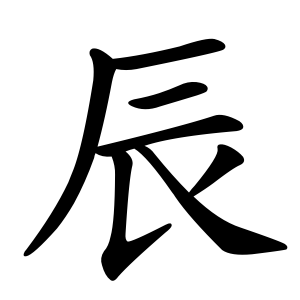辰
- star shin, time shin;
- name of a star;
It also refers to the fifth of the twelve Earthly branches (地支 dìzhī), and in that system, it symbolizes the dragon (龍).
Etymology
辰 is the 5th of the 12 Earthly Branches (十二支).
Symbolizes the dragon (龍), large land, earth, mountains, and twilight.
In the Heavenly Stems and Earthly Branches system, 辰 is associated with the element Earth, similar to 戌 (another Earth branch).
Its color associations are gold, metallic yellow, or golden yellow.
The hidden stems (藏干) inside 辰 are: 乙 (Wood), 癸 (Water), and 戊 (Earth).
Usage in Korean
진군 (辰君): A person born in the year of 辰.
진년 (辰年): The Year of the Dragon in the sexagenary cycle.
진시 (辰時): The fifth two-hour segment in the traditional 12-part division of the day, corresponding to 7 a.m. to 9 a.m.
진월 (辰月): The lunar third month, corresponding roughly to April in the Gregorian calendar. For leap months, it corresponds to May.
Five Elements with 辰 (Jin) in the sexagenary cycle:
Gap-jin (甲辰)
覆燈火 (복등화)
Meaning: Overturned or reversed fire, like an electric light or lamp flame.
Byeong-jin (丙辰)
沙中土 (사중토)
Meaning: Earth mixed with sand, sandy soil.
Mu-jin (戊辰)
大林木 (대림목)
Meaning: Large forest wood, big trees.
Gyeong-jin (庚辰)
白랍금 (백랍금)
Meaning: White waxy metal, such as ice, glaciers, lead, soft metals that require time to harden.
Im-jin (壬辰)
長流水 (장류수)
Meaning: Long flowing water, a large river.
- 一一一女 (MMMV)
- ⿸ 厂 ⿱ 二 ⿰ 𠄌 ⿺ 乀 丿 (G J K)
- ⿸ 厂 ⿸⿱ 二 𠄌 ⿺ 乀 丿 (H T V)
